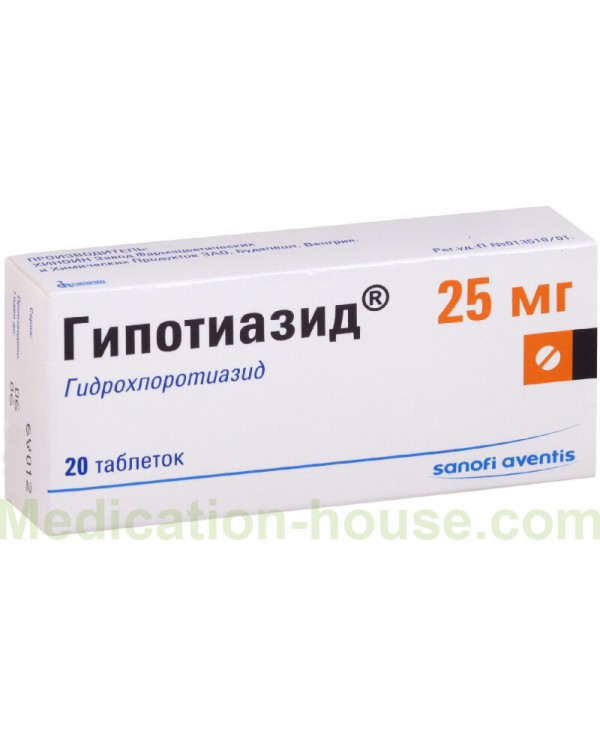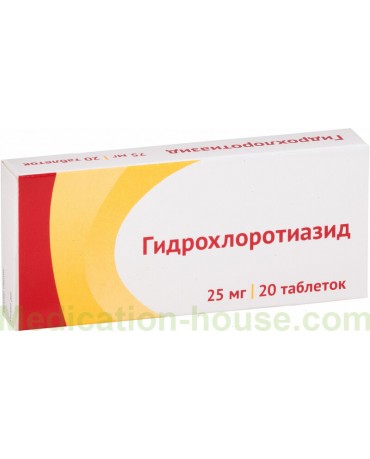Instruction for Hypothiazid
Reed more and buy Hypothiazid on this page
Hypothiazid is a diuretic.
Release form and composition
Dosage form: tablets are round, flat, with a dividing line on one side and engraving "H" - on the other, white or almost white (20 pcs. In blisters, in a cardboard box 1 blister and instructions for the use of Hypothiazid).
The active ingredient is hydrochlorothiazide, its content in 1 tablet is 25 or 100 mg.
Auxiliary components: gelatin, magnesium stearate, corn starch, talc, lactose monohydrate.
Pharmacodynamics
The active component of Hypothiazid is a thiazide diuretic hydrochlorothiazide, the primary mechanism of action of which is to increase diuresis by inhibiting the reabsorption of sodium and chlorine ions in the initial part of the renal tubules. As a result, the excretion of sodium, chlorine, and, accordingly, water from the body increases. In addition, the excretion of other electrolytes - potassium and magnesium - increases. The diuretic / natriuretic effect of all thiazides when taken at maximum therapeutic doses is approximately the same.
The natriuretic and diuretic effects occur in 2 hours, the maximum level is reached after about 4 hours.
Thiazide diuretics, in addition, by increasing the excretion of bicarbonate ions, reduce the activity of carbonic anhydrase, but usually this effect is weak and does not affect urine pH.
Hydrochlorothiazide has antihypertensive properties. Thiazide diuretics do not affect normal blood pressure (BP).
Pharmacokinetics
Hydrochlorothiazide is not completely absorbed from the gastrointestinal tract, but rather quickly, absorption continues for 6-12 hours. After oral administration of 100 mg of the substance, its maximum plasma concentration (Cmax) is reached after 1.5-2.5 hours. At the peak of diuretic activity (after about 4 hours after administration), the plasma level of hydrochlorothiazide is 2 μg / ml.
The thiazide diuretic binds to plasma proteins by 40%.
Hydrochlorothiazide passes into breast milk during lactation and passes through the placental barrier.
The primary route of excretion is by the kidneys, unchanged, through filtration and secretion. The half-life (T1 / 2) in patients with normal renal function is 6.4 hours.In patients with moderate renal insufficiency, T1 / 2 is 11.5 hours.When creatinine clearance (CC) is less than 30 ml / min, this indicator increases to 20 , 7 hours
Indications for use
Edema syndrome of various origins: portal hypertension, nephrotic syndrome, chronic renal failure, chronic heart failure, acute glomerulonephritis, premenstrual tension syndrome;
Arterial hypertension: monotherapy and treatment in combination with other antihypertensive drugs;
Prevention of stone formation in the urinary tract: reduction of hypercalciuria in predisposed patients;
Control of polyuria: mainly in nephrogenic diabetes insipidus.
Contraindications
Severe liver failure;
Severe renal failure;
Difficult to control diabetes mellitus;
Anuria;
Addison's disease;
I trimester of pregnancy and the period of breastfeeding;
Refractory hyponatremia, hypokalemia, hypercalcemia;
Age up to 3 years;
Hypersensitivity to the components of Hypothiazid and to sulfonamide derivatives.
With caution, it is recommended to prescribe Hypothiazid in the II and III trimesters of pregnancy, in patients with coronary heart disease (CHD), with hypercalcemia, hyponatremia, hypokalemia, liver cirrhosis, lactose intolerance, gout, in the case of simultaneous use of cardiac glycosides and elderly patients.
Hypothiazid, instructions for use: method and dosage
Hypothiazid tablets are taken orally after meals.
The dose is selected individually during treatment. Assessing the clinical condition of the patient, the doctor prescribes the minimum effective dose of Hypothiazid.
Initial dosage for adults:
Edema syndrome of various etiology: 25-100 mg once a day or once every 2 days, in severe cases - 200 mg per day. Given the clinical reactions, it is possible to reduce the dose to 25-50 mg per day once or once every 2 days;
Syndrome of premenstrual tension: 25 mg once a day, the intake begins from the moment the first symptoms appear before the onset of menstruation;
Arterial hypertension (combined and monotherapy): 25-50 mg once a day, for some patients 12.5 mg is enough. The minimum effective dose should not exceed 100 mg per day. The therapeutic effect is manifested within 3-4 days, for optimal stabilization of blood pressure (BP) it may take 3-4 weeks. After the cancellation of Hypothiazid, the hypotensive effect lasts for 1 week. To prevent a strong decrease in blood pressure with combination therapy, it may be necessary to reduce the dose of other antihypertensive drugs;
Nephrogenic diabetes insipidus: 50-150 mg daily in divided doses.
The dosage of Hypothiazid for children is calculated taking into account the weight of the child. The pediatric daily dose is usually 1-2 mg per 1 kg of the child's weight or 30-60 mg per 1 sq. M. body surface 1 time per day, for children from 3 to 12 years old - 37.5-100 mg per day.
Side effects
The use of Hypothiazid can cause the following side effects:
Digestive system: anorexia, diarrhea or constipation, cholecystitis, cholestatic jaundice, pancreatitis, sialoadenitis;
Metabolism: lethargy, confusion, slowing down of the thinking process, convulsions, excitability, fatigue, muscle cramps against the background of hypercalcemia, hypomagnesemia, hypokalemia, hyponatremia. Irregular heart rhythm, dry mouth, thirst, unusual fatigue or weakness, changes in the psyche or mood, cramps and muscle pain, nausea, vomiting against the background of hypochloremic alkalosis (in addition, hypochloremic alkalosis can cause hepatic encephalopathy or coma). Glycosuria, hyperuricemia with the development of a gout attack. Hyperglycemia, which can provoke the development of previously latent diabetes mellitus. High-dose treatment can lead to an increase in serum lipids;
Cardiovascular system: arrhythmia, vasculitis, orthostatic hypotension;
Hematopoietic system: very rarely - thrombocytopenia, leukopenia, hemolytic anemia, agranulocytosis, aplastic anemia;
Nervous system: temporary blurred vision, headache, dizziness, paresthesia;
Urinary system: interstitial nephritis, renal functional disorders;
Allergic reactions: urticaria, photosensitivity, necrotizing vasculitis, purpura, Stevens-Johnson syndrome, anaphylactic reactions up to shock. Respiratory distress syndrome, including pneumonitis and noncardiogenic pulmonary edema;
Others: decreased potency.
Overdose
Symptoms of an overdose of hydrochlorothiazide due to acute loss of fluid and electrolytes may include: thirst, nausea / vomiting, decreased blood pressure, tachycardia, shock, weakness, dizziness, confusion, paresthesia, spasms of the calf muscles, general fatigue, impaired consciousness, polyuria / oliguria / anuria ( due to hemoconcentration), alkalosis, hyponatremia, hypokalemia, hypochloremia, an increase in the level of urea nitrogen in the blood (especially in patients with renal failure).
It is recommended to induce artificial vomiting, gastric lavage, and take activated charcoal. A decrease in blood pressure or a state of shock requires replacement of circulating blood volume (BCC) and electrolytes (including potassium, sodium). It is necessary to monitor the state of water and electrolyte balance (especially serum potassium levels) and kidney function until their normal values are established. There is no specific antidote for a thiazide diuretic.
Special instructions
During a long course of treatment, it is necessary to monitor the clinical signs of a violation of the water-electrolyte balance, especially in patients with impaired liver function, diseases of the cardiovascular system.
The use of Hypothiazid contributes to the enhanced excretion of magnesium and potassium ions, therefore, in parallel, during the treatment process, it is necessary to take measures to eliminate their deficiency.
In patients with reduced renal function, it is necessary to systematically monitor creatinine clearance, in case of the onset of oliguria, the question of canceling Hypothiazid should be resolved.
In patients with impaired liver function, thiazides should be used with caution, since minor changes in water-electrolyte balance and serum ammonium levels can cause hepatic coma.
The use of Hypothiazid in patients with severe coronary and cerebral sclerosis requires special care.
Long-term treatment for latent and overt diabetes mellitus must be accompanied by systematic monitoring of carbohydrate metabolism and dose adjustment of hypoglycemic drugs.
Patients with impaired uric acid metabolism require continuous assessment.
Long-term therapy, in rare cases, can lead to pathological changes in the parathyroid glands.
Influence on the ability to drive vehicles and complex mechanisms
At the initial stage of therapy, it is forbidden to drive vehicles and perform work requiring increased attention, the duration of the prohibition period is determined individually.
Application during pregnancy and lactation
Hydrochlorothiazide passes through the placental barrier, and therefore there is a risk of fetal / newborn jaundice, thrombocytopenia and other negative reactions.
The use of Hypothiazid in the first trimester of pregnancy is categorically contraindicated. In the II-III trimesters, the drug is prescribed only if necessary, when the intended benefit to the mother is higher than the potential risk to the fetus.
Hydrochlorothiazide is excreted in breast milk during lactation. If it is necessary to use it during this period, it is required to stop breastfeeding.
Childhood use
In pediatric practice, the tablets are not used to treat children under the age of 3 years due to the solid dosage form of the drug.
With impaired renal function
The use of the drug is contraindicated in patients with severe renal failure (with CC <30 ml / min).
For violations of liver function
The use of Hypothiazid is contraindicated in patients with severe hepatic insufficiency.
With cirrhosis of the liver, the drug should be used with caution. Also, with special precautions, Hypothiazid should be used for liver dysfunction or progressive liver disease, since minor changes in water and electrolyte metabolism can cause hepatic coma.
Use in the elderly
When using Hypothiazid, elderly patients should be careful.
Drug interactions
The simultaneous use of hydrochlorothiazide with lithium salts is not recommended, since its toxicity increases against the background of a decrease in renal clearance of lithium.
Simultaneous use of a diuretic: with cardiac glycosides may increase the toxicity of digitalis; amiodarone - increases the risk of arrhythmias associated with hypokalemia.
Hypothiazid reduces the effectiveness of oral hypoglycemic agents, which increases the risk of developing hyperglycemia.
Taking the drug with corticosteroids, calcitonin helps to increase the degree of potassium excretion.
When combined with non-steroidal anti-inflammatory drugs, cholestyramine, the hypotensive and diuretic effect of Hypothiazid decreases.
Hypothiazid may enhance the effect of non-depolarizing muscle relaxants.
Concomitant use with amantadine can cause a decrease in its clearance and increase the risk of toxicity.
Concomitant use with barbiturates, ethanol, opioid analgesics increases the orthostatic hypotensive effect.
Hypothiazid should be discontinued before testing for the function of the parathyroid glands.
Terms and conditions of storage
Store in a dark place at temperatures up to 25 ° C. Keep out of the reach of children.
The shelf life is 5 years.
Reviews
Due to the fact that a thiazide diuretic promotes the rapid elimination of excess fluid from the body, most reviews of Hypothiazid are positive. Patients note its mild diuretic effect, strong diuretic effect, good removal of edema and pressure reduction even with a single dose of pills. The cost of the drug is called affordable. At the same time, it is emphasized that the drug is not suitable for long-term uncontrolled use, since this is fraught with electrolyte imbalance and the loss of useful nutrients by the body.
Terms of sell
A prescription is not required to buy Hypothiazid.


